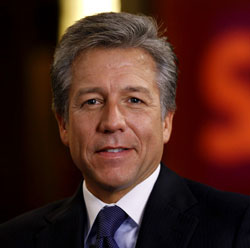The future battleground – The platform
While SAP is obviously competing against other software vendors for business, Watters sees these battles more as skirmishes. The real battleground of the cloud according to Watters is the platform.
“I think a key battle ground may well be the understanding of the integration of the portfolio. Rather than it being the best of breed vs best of breed. It’ll be ‘well I’m going to move to the cloud, how do I make sure that when I get to the ultimate destination of having most or all or most of my business in the cloud that it will all absolutely connect?’ You can almost say it becomes a platform battleground.”
He feels that SAP HANA is well placed to provide one of these platforms. This is not just because it provides a vehicle for SAP’s vast application portfolio, but as Watters explained: “I think that HANA in and of itself will continue to grow it is becoming recognized as being a technology that it becoming relevant to not just SAP customers. There are now 2,000 start ups developing independent applications on HANA now. That’s very interesting and revealing about what the world is looking for right now.”
With SAP able to offer probably the widest range of application already for its customers we asked Watters who the competition would be. He replied: “We will have the Hana platform and then a couple of others will emerge and become viable alternative platforms and many software vendors will have their own applications on what will become standard platform.
“Force.com and possibly Amazon will emerge with their web service platform.”
At the moment Amazon has a platform but it does not yet directly offer an integrated solution from that platform. However one of the smaller ERP companies Infor does sit on AWS. They have also just purchased another AWS client, Predictix. It will be interesting to see whether Infor provide the AWS application and if Amzon want to seriously enter this market whether they decide that an acquisition might be an option. Infor through Ion, has an integration platform that could be the basis for a wide spectrum of AWS client applications to integrate into.
Does this mean the birth of a new acronym, EPAAS, the ERP Platform as a Service? There are also some other points of view with companies like Workday using their own database although they integrate but do not share Salesforce.com (which currently sits on Oracle). Their thinking was explained in an interview with Phil Wilmington as a cloud of 5 integrated clouds.
Are platforms good for the customer?
Watter also believes that the migration to the cloud is good for customer choice, but there are challenges ahead for SAP. He explained further. “I do believe that cloud as a business paradigm has brought some hugely positive developments for the customer. In the cloud you are typically making a 3 or 5 year commitment. It isn’t necessarily as easy as all that to change out at the end of that period, but it is possible. I believe that change will become easier as the cloud matures.”
Switching won’t be easy though, Watters acknowledged that despite the transition from bespoke development of applications to configuration. What it does mean is that companies will consider the business case of moving more seriously rather than sinking development dollars into one system. A recent example of this is ASOS, who have signalled that they will be moving from NetSuite to Oracle.
For companies like SAP there are some areas of their business that they need to improve and for SAP customers they will be pleased that not only is Watters is aware but likely to something about it. He added “It drives a far higher need for excellent customer service from SAP and from other software vendors and I think it is the focus of customer service and retention that will drive the return for the customer. It’s a very good situation for the customer to be in.
I think you will get to the platform conversation again. If you can get that there are multiple applications available on the same platform again and you can plug and play. I think it will become a very customer centric world as we go forward.”
Conclusion

There is little doubt that the SAP results were positive and as Bill McDermott, CEO of SAP stated in the press release: “Our strength in 2015 shows that the S/4HANA innovation cycle is well underway.
“Our completeness of vision in the cloud has distinguished SAP from both legacy players and point solution providers. We beat on cloud and software, we beat on operating income and we are ever confident that SAP will remain a profitable growth business well into the future.”
SAP need to continue to win new customers, but also help migrate their existing ones to the cloud. If they can continue to do so then they should stay as the No. 1 ERP company.
Watters ignored Oracle as having a platform for the future but it is unlikely that they will remain silent for much longer. The question is whether they are more focused on protecting their on-premises revenue than migrating customers to the cloud. It will be interesting to see how they look to challenge the growth of SAP HANA.

























